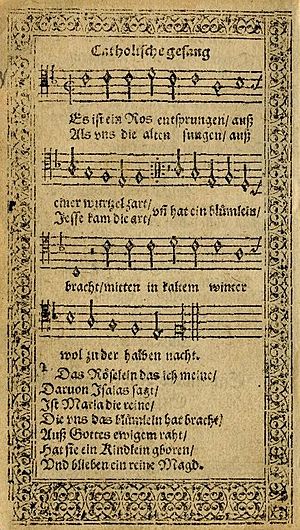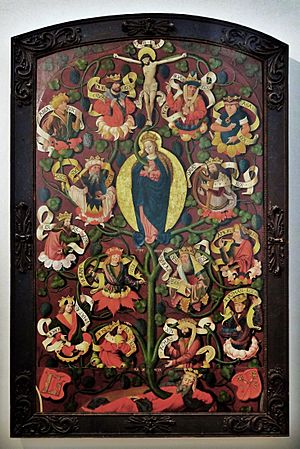Es ist ein Ros entsprungen facts for kids
Quick facts for kids "Es ist ein Ros entsprungen" |
|
|---|---|
| German Christmas hymn by Anonymous | |

First printed in the 1599 Speyer Hymnal
|
|
| Genre | Hymn |
| Occasion | Christmas |
| Text | Unknown author |
| Language | German |
"Es ist ein Ros entsprungen" (which means "A rose has sprung up") is a famous Christmas carol and a song about Mary, the mother of Jesus. It comes from Germany. In English, it's often called "Lo, how a rose e'er blooming". Other names include "A Spotless Rose" and "Behold a Rose of Judah".
The rose in the German song is a special symbol for the Virgin Mary. The hymn talks about old predictions from the Book of Isaiah in the Old Testament. Christians believe these predictions were about Jesus becoming human. It also mentions the Tree of Jesse, which is a symbol showing Jesus's family tree. Because it talks about these predictions, the song is very popular during Advent, the time before Christmas.
No one knows who wrote this hymn, but it was before the 1600s. It first appeared in a book in 1599. Since then, it has been printed many times with different verses and in several languages. Most people sing it to a tune arranged by the German composer Michael Praetorius in 1609. The song is still loved and sung today.
What the Song Means

The hymn originally had two verses. These verses describe how the prediction from the prophet Isaiah came true with the birth of Jesus. It highlights Jesus's royal family line and Christian predictions about the Messiah.
The song talks about a rose growing from the stem of the Tree of Jesse. This is a symbol that shows Jesus came from Jesse of Bethlehem, who was the father of King David. This image was very popular in the Middle Ages and can be seen in many old religious artworks. It comes from the Book of Isaiah in the Bible, which says:
And there shall come forth a rod out of the stem of Jesse, and a Branch shall grow out of his roots.
The second verse of the hymn explains what this symbol means. It says that Mary, Jesus's mother, is the rose that grew to bring the Christ child into the world. The child is called a "small flower" ("das Blümlein"). The German words say that Mary is a "pure maiden" ("die reine Magd"). This points to the Christian belief that Jesus was born when Mary was still a virgin. However, in an English translation from 1894 by Theodore Baker, the second verse says the rose symbolizes the baby Jesus himself.
Since the 1800s, more verses have been added to the song, both in German and in English translations.
History of the Song
The idea of Isaiah's prediction appearing in Christian songs goes back a long way. As early as the 700s, a writer named Cosmas the Melodist wrote a hymn about Mary growing from the Root of Jesse.
The words of "Es ist ein Ros entsprungen" were written in the 1400s. We don't know who wrote them. The oldest copy is in a handwritten book from a monastery in Trier, Germany. This book is now kept in the Trier City Library.
The hymn first appeared in a printed book in 1599. This was the Speyer Hymnal. Both Catholics and Protestants have used the hymn. Catholics often focus on Mary in the song, while Protestants tend to focus on Jesus. Over time, many different versions of the hymn have been created, with different words and lengths. In 1844, a German hymn expert named Friedrich Layriz added three more verses. The first of these, "Das Blümelein so kleine", became very popular and is now in many Catholic and Protestant songbooks.
The tune we usually hear for the hymn first appeared in the Speyer Hymnal in 1599. The well-known arrangement of the tune was written by the German composer Michael Praetorius in 1609. There is also a version for four voices that sings the same melody at different times. This version is sometimes thought to be by Melchior Vulpius, who lived at the same time as Praetorius.
In 1896, the famous composer Johannes Brahms used the hymn's tune. He made it the basis for a special organ piece, one of his Eleven Chorale Preludes.
During the time of the Nazis in Germany, some German Christmas carols were changed. This was done to fit the new ideas of the government. "Es ist ein Ros entsprungen" was rewritten as "Uns ist ein Licht erstanden/in einer dunklen Winternacht" ("A light has arisen for us/on a dark winter night"). The new words talked about sunlight and praised motherhood, without mentioning the original religious meaning.
Other composers have also used the hymn's melody. Hugo Distler used it in his 1933 musical story called Die Weihnachtsgeschichte (The Christmas Story). Arnold Schoenberg's Weihnachtsmusik (1921) is a short piece for instruments that uses Es ist ein Ros entsprungen along with Stille Nacht. In 1990, Jan Sandström wrote a piece for two choirs called Es ist ein Ros entsprungen. It includes Praetorius's arrangement in one of the choirs.
English Translations
Many well-known English versions of the hymn have been published. Theodore Baker wrote "Lo, How a Rose E'er Blooming" in 1894. You can find it in the Psalter Hymnal and The United Methodist Hymnal.
The British hymn translator Catherine Winkworth translated the first two verses as "A Spotless Rose". In 1919, the British composer Herbert Howells set these words to music for a choir. Howells said that he wrote "A Spotless Rose" while watching trains from his window in Gloucester. He wrote it and dedicated it to his mother. He said it always moved him when he heard it, as if someone else had written it.
Howells' carol is special because it changes its musical rhythm often. The ending, "On a cold, cold winter's night," is very famous for its beautiful sound. Another composer, Patrick Hadley, reportedly said he wished to pass away while hearing that part of the song. Winkworth's translation was also set to music in 2002 by the British composer Sir Philip Ledger.
Another English translation, "Behold, a rose is growing," was written by the American musician Harriet Reynolds Krauth Spaeth (1845–1925). Her four-verse version is often printed with a fifth verse added by the American writer John Caspar Mattes (1876–1948).
There's another Christmas hymn called "A Great and Mighty Wonder" that uses the same tune. This can sometimes cause confusion. However, it's a different hymn by St. Germanus, translated from Greek by John Mason Neale in 1862. Sometimes, parts of the German lyrics have been mixed with Neale's translation of the Greek hymn in later versions, like in the 1931 Songs of Praise and Carols for Choirs (1961).
Lyrics
| German original | Baker's version | Winkworth's version | Spaeth's translation with Mattes' 5th verse |
|---|---|---|---|
|
Es ist ein Ros entsprungen, |
Lo, how a rose e'er blooming, |
A Spotless Rose is blowing, |
Behold, a Branch is growing |
|
Das Röslein, das ich meine, |
The Rose which I am singing, |
Isaiah hath foretold it |
|
|
The shepherds heard the story, |
|||
|
Das Blümelein, so kleine, |
O Flower, whose fragrance tender |
This Flow'r whose fragrance tender |
|
|
Lob, Ehr sei Gott dem Vater, |
|||
|
O Jesu, bis zum Scheiden |
O Saviour, Child of Mary, |
Music
<score raw sound> \header { arranger = "Setting: Michael Praetorius" tagline = ##f } \layout { indent = 0 \context { \Score \remove "Bar_number_engraver" } } global = { \key f \major \time 4/4 \partial 2 }
soprano = \relative c { \global \set Staff.midiPanPosition = -0.5 \set midiInstrument = "violin" \repeat volta 2 { c2 | c4 c d c | c2 a | bes a4 g~ | g f2 e4 | f2 } \break r4 a | g e f d | c2 r4 c' | c c d c | c2 a | bes a4 g~ | g f2 e4 | f2 \bar "|." }
alto = \relative c { \global \set Staff.midiPanPosition = 0.5 \set midiInstrument = "violin" \repeat volta 2 { a2 | a4 f f f | e2 d | d c4 c | d4. (a8) c2 | c } r4 f | d c c b | c8 (d e4) r e | g f f f | e2 d | d f4 d | e (f g) c, | c2 \bar "|." }
tenor = \relative c' { \global \set Staff.midiPanPosition = -1 \set midiInstrument = "viola" \repeat volta 2 { c2 | c4 a bes a | g2 f | f a4 c | bes (a2) g4 | a2 } r4 c | bes a a g | g2 r4 g | g a bes a | g2 fis | g c4 bes | a2 g | a2 \bar "|." }
bass = \relative c { \global \set Staff.midiPanPosition = 1 \set midiInstrument = "cello" \repeat volta 2 { f2 | f4 f bes f | c2 d | bes f'4 e | d2 c | f, } r4 f' | g a f g | c,2 r4 c | e f bes, f' | c2 d | g, a4 bes | c2 c | f,2 \bar "|." }
verse = \lyricmode { Es ist ein Ros ent -- sprun -- gen aus ei -- ner Wur -- zel zart, Und hat ein Blüm -- lein bracht, mit -- ten im kal -- ten Win -- ter, wohl zu der hal -- ben Nacht. } verseR = \lyricmode { Wie uns die Al -- ten sun -- gen, von Jes -- se kam die Art, }
\score { \new ChoirStaff << \new Staff \with { \consists "Merge_rests_engraver" } << \new Voice = "soprano" { \voiceOne \soprano } \addlyrics { \verse } \addlyrics { \verseR } \new Voice = "alto" { \voiceTwo \alto } >> \new Staff \with { \consists "Merge_rests_engraver" } << \clef bass \new Voice = "tenor" { \voiceOne \tenor } \new Voice = "bass" { \voiceTwo \bass } >> >> \layout { } } \score { \unfoldRepeats { << \soprano \\ \alto \\ \tenor \\ \bass >> } \midi { \tempo 4=100 \context { \Score midiChannelMapping = #'instrument } \context { \Staff \remove "Staff_performer" } \context { \Voice \consists "Staff_performer" } } } </score>
See also
 In Spanish: Una rosa ha brotado para niños
In Spanish: Una rosa ha brotado para niños

